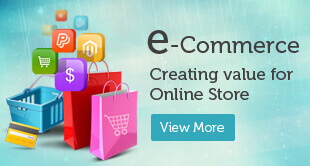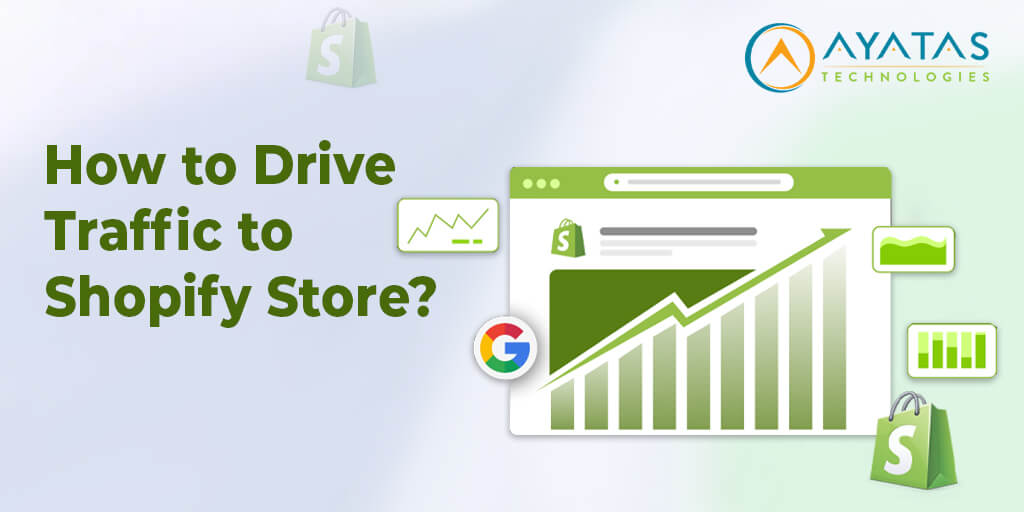
How to Drive Traffic to Shopify Store?
Whether you are an experienced online merchant or a beginner looking to launch your eCommerce store, you should know how to increase website traffic. Many merchants are trying to drive more visitors to their websites. Thanks to the available channels for driving more traffic to your Shopify store. You don’t need to use all the available channels. Your budget and goals decide the usage. In this article, we will look into the topic of How to drive traffic to Shopify store. Let’s get started!
30+ Practical Ways to Drive Traffic to Your Shopify Store
Below, we have mentioned some of the sources for driving traffic to your store, and each of them is elaborated:
Search Engine Optimization
Optimize your Shopify store to rank top for relevant searches. To do so, you have to do keyword research, On-page SEO, off-page SEO, and technical SEO to attract potential customers who come organically from search engines.
Content Marketing
Create content to engage customers by frequently publishing blogs, guides, how-to videos, FAQs, videos, and other interactive content to draw visitors.
Social Media
Leverage social media platforms like Instagram, TikTok, Facebook, YouTube, and others to interact with your followers and use paid ads to target new customers.
Influencer and Affiliate Marketing
Collaborate with social media influencers to reach a wider audience and drive sales. Influencers have a huge reach and fan base. Most customers trust their recommendations over brands. Offer coupons and commissions to motivate them to promote your online store to their followers.
Email is the most engaging and effective way of promoting your product. Email marketing campaigns can convert traffic to sales, as customers feel the product is unique and reach your website from their inbox.
Referral Programs
Offer incentives to your customers who refer your product. A properly executed referral program can easily attract traffic to your store. Other platforms or Shopify apps let others promote your product on a commission basis.
Community and Forum Engagement
Participate in online communities or FORUMs in your category and interact with product users or potential customers. Answer genuinely to drive targeted traffic to your website.
Giveaways
Run contests, giveaways, or limited-time promotions where participants can ask their friends to join. This can dramatically increase the reach and attract new customers. Shopify offers some tools for running sweepstakes and tracking them.
Offline Marketing
Participate in trade shows, local events, workshops, and sponsorship events to showcase your products to the public and drive more traffic to your online store. Distribution of business cards, flyers, and samples can also be beneficial.
The sections below detail each strategy. Let’s examine each traffic source with practical tips.
1. Search Engine Optimization (SEO)
SEO is the most preferred approach for any online store to reach customers. About 33% of the traffic comes from organic search only. Below are the key SEO steps:
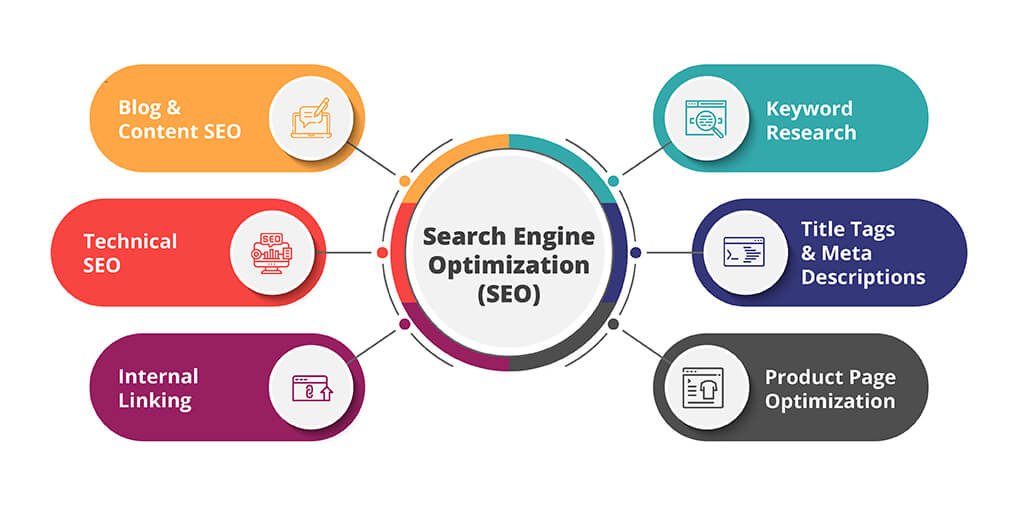
- Keyword Research: Identify what terms your customers search for. Use tools like Google Keyword Planner, Ahrefs, or Semrush to find keywords with high search volume that match your products and content ideas. Consider long-tail phrases, which have less competition and attract qualified shoppers.
- Title Tags & Meta Descriptions: Write concise title tags that include your target keyword and match search intent. Craft compelling meta descriptions summarizing the page so users click through. Google notes that “title tags…are often the primary information used to decide which result to click on”. Each page on your Shopify store should have a unique title and meta description optimized with relevant keywords.
- Product Page Optimization: Use descriptive, keyword-rich product titles and detailed descriptions. Include important specs or use cases. Use bullet lists for specs. High-quality images with descriptive filenames and alt text also help SEO and accessibility.
- Blog & Content SEO: Shopify has a built-in blog that can be used to publish articles that answer customer questions or showcase products. Each blog post should be optimized: include the keyword in the URL, title, headings, and body. Write content that solves problems or provides inspiration. One Shopify guide notes that “blogging…is one of the best ways to build internal links, attract backlinks, and establish your business as credible,” boosting organic traffic.
- Technical SEO: Shopify handles many backend SEO tasks, but you should still ensure Fast site speed, Mobile Optimization, secure URLs, and structured data.
- Internal Linking: Link related products and content to each other within your store. Good internal linking improves navigation and helps Google discover your pages. It also passes “link juice”: when you link from a high-authority page to a target page, you boost that page’s chances of ranking. Shopify’s breadcrumbs and product suggestions help automate internal links.
- Backlinks (Off-Page SEO): Encourage other reputable sites to link to yours. Backlinks from authoritative blogs or news sites signal to Google that your site is trustworthy. These include guest posting on industry blogs, creating shareable content, sending products to bloggers for review, and issuing press releases when you have news. Even participating in niche forums with your link can help. These backlinks can take time but pay off: Google’s algorithms weigh backlinks heavily as a ranking factor.
- Local SEO: If you serve local customers, claim a Google Business Profile with your Shopify store. Get your shop listed on Google Maps and relevant directories. Encourage customers to review you on Google and Yelp. Local signals help Google show you to shoppers “near me” and boost organic traffic from local queries.
2. Content Marketing: Blogs, Videos, Podcasts, and More
Quality content brings eager shoppers to your store. Instead of hard-selling, content marketing focuses on creating helpful, informative, or entertaining content that attracts your target audience. This not only drives traffic but also builds trust in your brand.
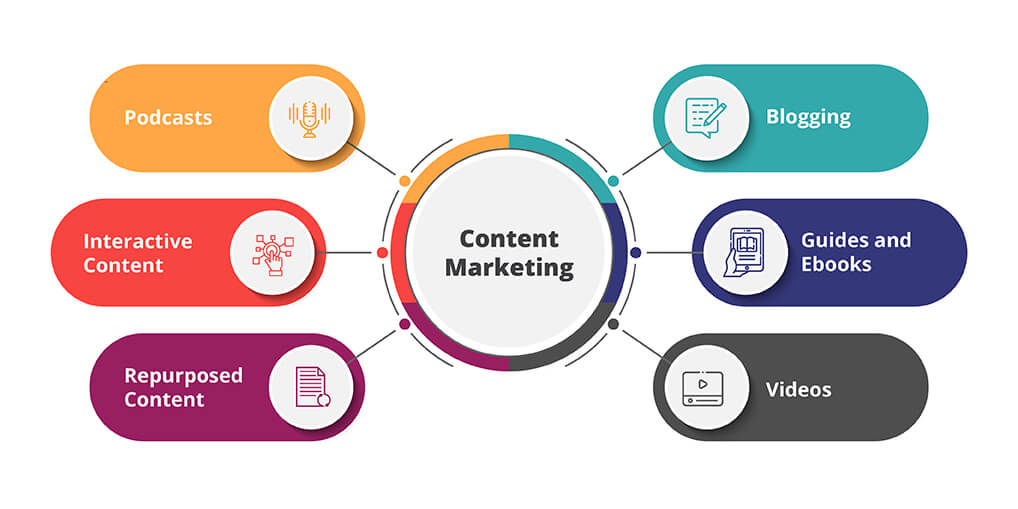
- Blogging: Regular blog posts are a simple yet powerful content strategy for Shopify stores. Write posts around customer questions, trends, or stories related to your niche. Each post should aim to answer a query or solve a problem, which helps it rank in Google. Optimize each post for SEO and use a clear structure with headings. Include a call-to-action at the end linking to a relevant product or category. Over time, a blog builds up numerous entry points, internal links, and backlinks, significantly boosting organic traffic.
- Guides and Ebooks: Create comprehensive guides or ebooks for more in-depth engagement. Use them as lead magnets or provide them for free to establish authority. Such long-form content often attracts backlinks and shares, extending reach.
- Videos: YouTube is now the world’s second-largest search engine, with 2.7 billion active users. Produce videos like tutorials, product demos, and behind-the-scenes. Embed these on your site and share them on social media. Videos tend to engage users longer, building rapport. Product-centric videos are especially effective for Shopify store owners. Always include a visible link or overlay in the video pointing back to your store.
- Podcasts: While podcasts don’t have direct visual CTAs, they’re excellent for building a loyal audience. If you or your team have expertise, start a podcast on topics your customers care about. Mention your store and products naturally during episodes, and include links in the episode notes.
- Interactive Content: Quizzes, calculators, or interactive tools can engage users and drive traffic. For example, a pet shop could have a “Find your perfect dog breed” quiz, collecting leads and product links. Shopify merchants have used quizzes to great effect.
- Repurposed Content: Cross-publish content across channels. A single blog post can be turned into a series of Instagram posts, a video summary, or LinkedIn articles. This extends the reach and ensures you can link to your store from multiple platforms.
- Content Partnerships: Collaborate with influencers or other brands to put your content in front of a larger audience.
Pro Tip: Always align content with your target audience’s needs. For B2B Shopify stores, focus on detailed product sheets, case studies, and whitepapers that solve business problems. For B2C, use more visual and lifestyle content. Whatever the format, consistency is key: the longer you persist, the more compounding traffic you get.
3. Organic Social Media Engagement
Social media platforms allow you to reach and engage customers directly. Organic social strategies can steadily grow your Shopify store’s visibility:
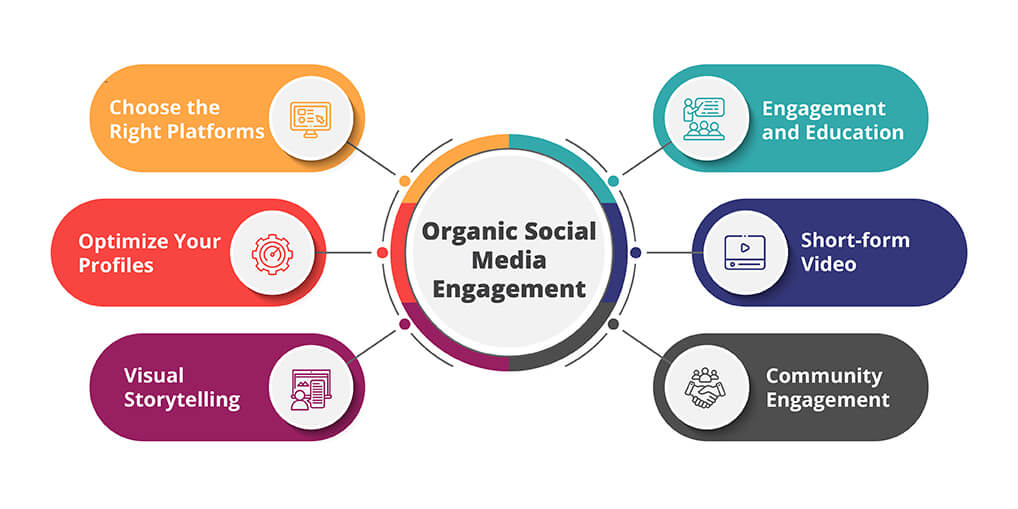
- Choose the Right Platforms: Not every platform suits every store. Instagram, Facebook, Pinterest, and TikTok are popular for B2C retail, while LinkedIn and Twitter may be better for B2B. Consider where your audience spends time.
- Optimize Your Profiles: Ensure each social profile represents your brand and links to your store. Use a link-in-bio tool to share multiple product links from Instagram or TikTok bios.
- Visual Storytelling: Instagram and Pinterest favor high-quality images. Show your products in lifestyle settings or before/after shots. Use Instagram Stories/Reels for short behind-the-scenes clips, product teasers, and quick tips.
- Engagement and Education: Post helpful tips, polls, or user-generated content on Facebook or LinkedIn to start conversations.
- Short-form Video: TikTok and Instagram Reels emphasize raw, authentic videos. Share product tutorials, quick demos, unboxings, or brand stories. As of 2025, TikTok has 2 billion monthly users, many of whom will engage with creative small-business content.
- Community Engagement: Encourage user-generated content by asking customers to share photos using your product with a branded hashtag. Feature these in your feed to build social proof.
- Be Responsive: Social media is a two-way street. Monitor comments and messages closely. Reply promptly to questions or feedback. Meaningful interactions build loyalty and encourage word-of-mouth shares.
- Encourage Sharing: Mobilize your network. In the early stages, ask friends and family to follow and share your posts to reach more people. Shopify notes that sites like Upworthy hit early goals by asking personal networks to share, creating “exponential reach” through word-of-mouth.
- Hashtags & Trends: Use relevant hashtags to increase discoverability. On platforms like Instagram and TikTok, hopping on a trending hashtag or sound can expose you to new audiences. But only participate if the trend fits your brand persona. As Shopify suggests, join trending conversations or memes creatively to expand reach.
- Scheduled Posting: Maintain a regular posting cadence. Tools like Later or Buffer can help you plan posts. Weekday evenings are often high-traffic times on social.
- Live Events: Host live Q&A sessions, product demos, or workshops (e.g., live craft tutorial if you sell crafts). Live videos on Instagram or Facebook often get priority in feeds.
- Analytics: Use each platform’s insights to track what content performs best (likes, shares, link clicks) and adjust accordingly. Look at demographics to ensure you’re attracting your target market.
Pro Tip: Organic social media is about building an engaged audience that trusts your brand. As Shopify notes, it’s generally a long-term, lower-cost, cheaper, and more sustainable strategy with long-term compounded value. Over time, an active social presence can bring steady referral traffic. It complements paid social ads by warming up your audience through genuine connections.
4. Paid Advertising (Search & Social Ads)
Paid ads let you quickly reach potential customers. A balanced ad budget can significantly boost traffic, especially when organic methods take time to scale. Key paid channels include:
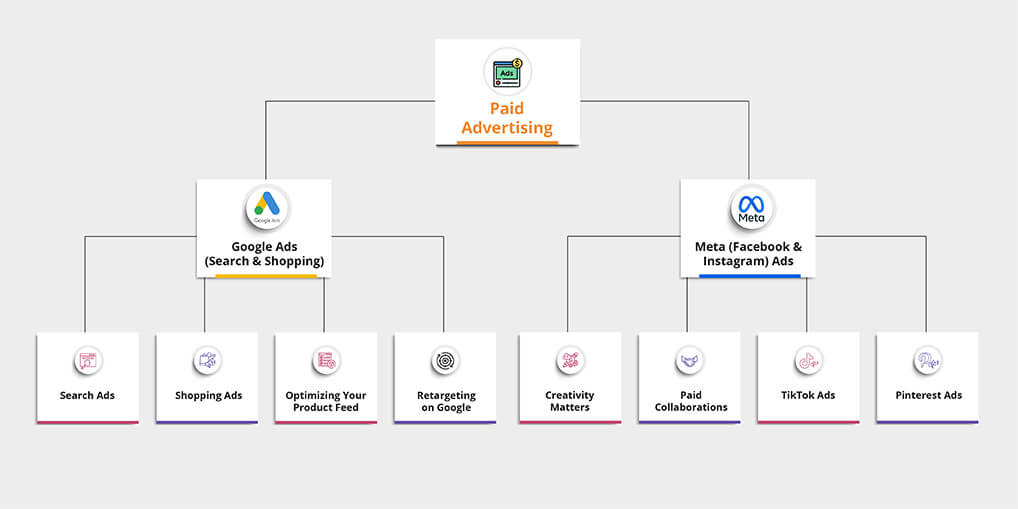
Google Ads (Search & Shopping)
- Search Ads: Bid on keywords so your Shopify products appear as sponsored results on Google search. Target both brand and non-brand keywords. Non-branded terms may cost more but bring in new customers.
- Shopping Ads: Set up a Google Merchant Center and link it to Shopify. Google’s free Product Listing Ads (PLAs) means your products can appear in Google’s Shopping tab and search results with images, prices, and titles.
- Optimizing Your Product Feed: Include strong titles, accurate categories, and high-quality images. Because these listings are so visible, 33% of clicks on Google go to the first organic result, and shopping ads often occupy that prime spot for e-commerce queries.
- Retargeting on Google: Use Google Ads to retarget previous visitors. Show them banner or text ads for products they viewed but didn’t buy, which will remind them to return.
Meta (Facebook & Instagram) Ads
With over 3 billion combined users, Facebook and Instagram allow very granular targeting. You can create campaigns that target by age, interests, behaviors, and even custom audiences. For Shopify stores, Facebook Dynamic Ads are powerful: upload your product catalog, and Meta will automatically show users the most relevant products.
- Creativity Matters: Use eye-catching images or short videos. Carousels work well for showing product variety. Always include a clear CTA. Test different ad copies and formats. Shopify says, “Fine-tune your CTA copy by tracking click-through rates to determine which CTAs compel subscribers the most.”
- Getting & Bidding: Start with a modest daily budget and test ads. Facebook’s algorithm will optimize delivery. A common strategy is to start with broad interests and then narrow down high-performing segments. Alternatively, create lookalike audiences.
- TikTok Ads: With 2 billion users worldwide and a content style that favors authenticity, TikTok Ads can drive traffic for the right product. Use trending music or challenges to make your ads blend into the feed. Tools like TikTok’s Pixel (integrated with Shopify) help track sales from TikTok ads.
- Pinterest Ads: Promoted Pins can be effective for visual products like home decor, fashion, and crafts. Target keywords like a search engine. When users discover your Pin, they click on your Shopify page.
- Google Display Ads: These run on the Google Display Network (millions of sites). They’re good for retargeting or brand awareness. Use attractive banners of your products to get clicks.
- Influencer/Paid Collaborations: Pay influencers to create branded content or ads featuring your products. This is like a hybrid of influencer marketing and paid ads. Platforms like Instagram allow you to boost a creator’s post to your chosen audience, turning influencer content into targeted ads. Shopify Collabs simplifies this process by letting you manage creators and commissions in one place .
Pro Tip: There’s no one-size-fits-all ad budget, but a common approach is to start small and scale what works. Track your Return on Ad Spend (ROAS). Performance varies by niche. Always track Shopify Analytics or Google Analytics metrics to ensure your ads are profitable.
5. Influencer and Affiliate Marketing
Leveraging influencers and affiliates extends your reach to new audiences who trust third-party recommendations.
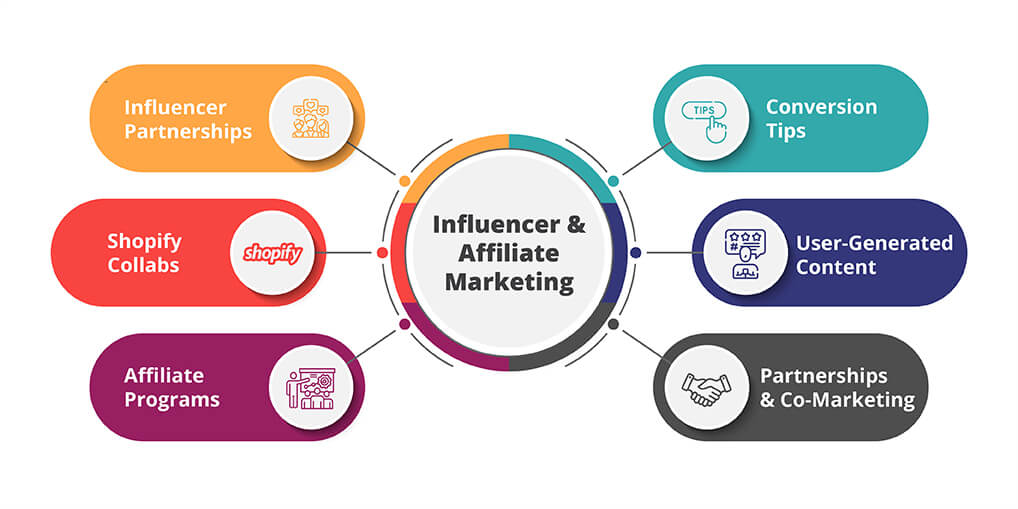
- Influencer Partnerships: Collaborate with social media influencers whose followers match your target market. Influencers can review your product, create sponsored posts, or share discount codes. Influencers vary: micro-influencers (1K–50K followers) often have highly engaged niches; macro-influencers (100K+) reach broad audiences. Choose based on your goals and budget.
- Shopify Collabs: To streamline this, use Shopify Collabs (the built-in affiliate/influencer manager). With Collabs, you can invite creators, give them unique links or codes, and track their performance from Shopify Admin. It even handles payments or rewards automatically.
- Affiliate Programs: An affiliate is an influencer with a performance-based model. They share your products via blogs, YouTube, or social in exchange for a commission on sales. The affiliate channel can yield very high ROAS (Shopify mentions it can average 12:1, meaning $12 back per $1 spent). To start, join an affiliate network or set up an affiliate app on Shopify. Provide affiliates with marketing assets and unique links. Offer incentives like exclusive discount codes they can share; 90% of shoppers hunt for coupons, and affiliates love having deals to promote.
- Conversion Tips: Boost affiliate conversions by offering limited-time deals or bundling products to create urgency. Ensure your landing pages are optimized and fast-loading, have clear CTAs, and have trust signals (like reviews and secure checkout) to convert the traffic affiliates send.
- User-Generated Content (UGC): Encourage satisfied customers to create content (reviews, photos, videos) for a small incentive. Share this UGC on your social site. People are more likely to trust peers than ads. You can even create a referral program where customers get a discount for submitting a testimonial or referring a friend.
- Partnerships and Co-Marketing: Partner with non-competing brands that share your audience. For instance, a yoga mat seller might collaborate with an activewear brand to do a joint giveaway or cross-promotion. Both brands benefit from each other’s followers.
Quick Steps to Implement:
- Identify Influencers: Look for creators whose followers match your niche. Tools like Impact, CreatorIQ, or even manual search can help.
- Reach out Professionally: Send a friendly pitch highlighting why your product fits their audience. Offer free samples in exchange for an honest review.
- Set Clear Terms: For affiliates, specify commission rates and cookie durations. For influencers, agree on deliverables (post count, platforms, usage rights) and compensation (flat fee or free product plus commission).
- Provide Assets: Give images, logos, product info, and discount codes to make promotion easy.
- Track Performance: Use unique UTM links or codes to attribute traffic/sales. Adjust strategy—double down on partnerships that bring good traffic and conversions.
6. Email and SMS Marketing
Email marketing is a direct line to past visitors and customers, making it a top traffic driver with minimal cost. According to HubSpot data, for every $1 you spend on email marketing, the average return is $36. In other words, a small email list can yield big returns. Here’s how to leverage it:
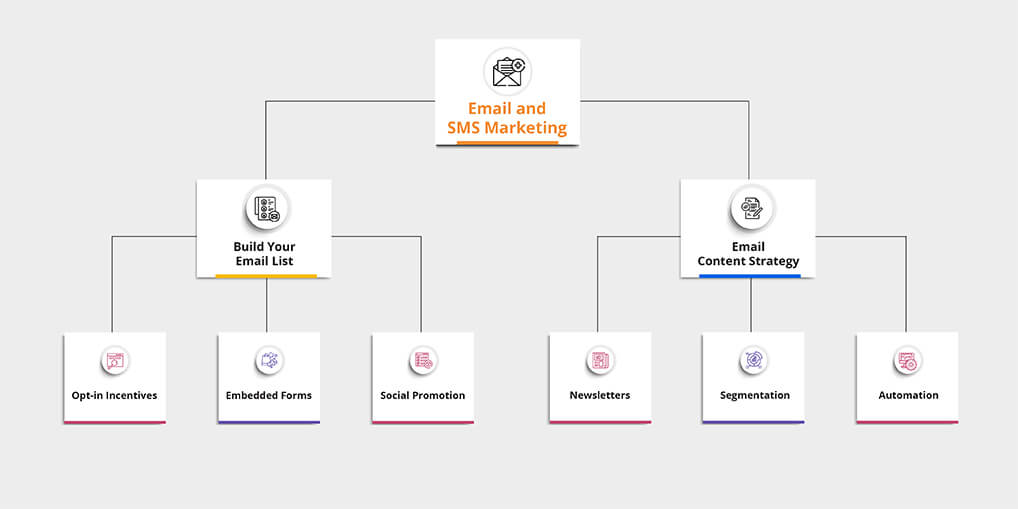
Build Your Email List:
- Opt-in Incentives: Offer visitors a reason to sign up, such as discount codes, a free guide, or entry into a giveaway. For example, a popup on your Shopify site might say, “Join our email list and get 15% off your first order.”
- Embedded Forms: Place signup forms prominently (header, footer, or sidebar). After checkout, invite customers to subscribe. You can also use Shopify apps to create splash pages or popups for promotions.
- Social Promotion: Share your newsletter on social media, e.g., “Our subscribers get exclusive product drops!” and link to a signup page.
Email Content Strategy:
- Newsletters: Send regular emails (e.g., weekly or monthly) with updates, such as new product launches, blog highlights, or helpful tips. Keep them short and skimmable. Shopify recommends writing short paragraphs (2–5 sentences) and using headers, bullets, and images. This makes it easy for readers to scan.
- Segmentation: Divide your list based on customer behavior. Send targeted offers, and even basic segmentation (like location or interest) can boost open rates.
- Automation: Set up automated flows (Shopify Email or third-party ESPs). Examples:
- Welcome Series: When someone signs up, send a welcome email series introducing your brand and offering a first-time purchase code.
- Abandoned Cart: If a subscriber leaves items in the cart, send a reminder after a few hours or a day. These can recover 10–15% of lost sales.
- Browse Abandonment: If they viewed products without adding to the cart, send suggestions.
- Post-purchase Follow-ups: Thank new customers, request reviews, or suggest complementary products.
- Focus on Value: As noted by Shopify experts, “email marketing nurtures long-term relationships with customers by offering value and keeping them engaged.” Don’t just send sales pitches—include educational or entertaining content. For example, a gourmet food store might share recipes using its ingredients.
- Design & Deliverability: Ensure emails look good on all devices. Use responsive templates and concise subject lines. Include alt text on images and plain-text links for accessibility. Avoid spammy phrases and always include an unsubscribe link to comply with laws.
- SMS/Text Marketing: Text messages have very high open rates. Use SMS sparingly for urgent or flash sales. Shopify offers integrations for SMS campaigns. Always get explicit opt-in and remind customers of frequency/facts.
- Owned Media Advantage: Unlike ads or social media, email/SMS lists are yours. Shopify explains that “email marketing is an owned media channel,” meaning you store contact info internally. This protects you from algorithm changes or ad bans.
- Measure Results: Track email metrics in Shopify or your ESP. Key metrics: open rate (aim for 20%+), click-through rate, and conversion rate (how many email clicks turn into sales). Continuously test subject lines, send times, and content. Even small tweaks can improve performance.
7. Referral and Loyalty Programs
Word-of-mouth is one of the most trusted forms of marketing. Referral programs formalize this: reward customers who spread the word.
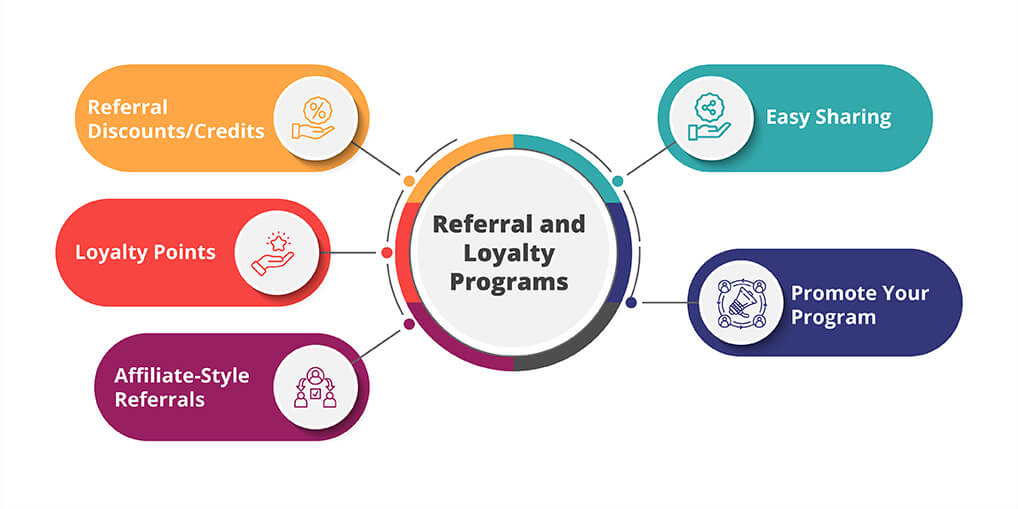
- Referral Discounts/Credits: Offer customers a reward (discount, store credit, gift) when their friends make a purchase. For example, Tentree’s program gives the referrer a $20 credit and the new customer 20% off. This “two-sided incentive” encourages sharing and conversion.
- Loyalty Points: Customers who earn points for purchases or referrals that they can redeem later are more likely to promote you. A simple Shopify loyalty app can track points and automate rewards.
- Affiliate-Style Referrals: Enable anyone (even those who are not past customers) to refer by signing up. They can share a unique link or code and earn a commission or flat reward per sale, similar to an affiliate program. Shopify Collabs or apps like Refersion facilitate easy referral link generation and tracking.
- Easy Sharing: Provide pre-written social posts or emails that customers can forward to friends.
- Promote Your Program: Publicize your referral program on your website (banner or popup), in order confirmation emails, and social. The more people know about it, the more it spreads.
Why It Works: People trust recommendations from friends and family. According to Shopify forums, encouraging referrals taps into social proof and can “increase traffic” by leveraging existing relationships. It turns your customers into a volunteer marketing force.
8. Community Engagement and Forums
Building a community around your brand or participating in niche forums can drive targeted traffic and foster brand advocates.
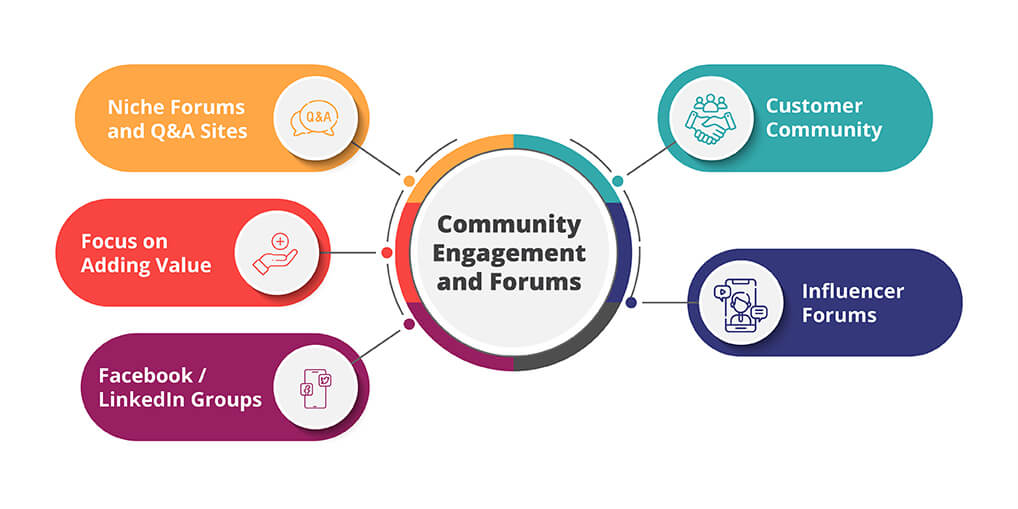
- Niche Forums and Q&A Sites: Reddit, Quora, Stack Exchange, or specialized forums often have passionate communities. Find relevant subreddits or forums for your products. When someone asks a question you can help with, give a thorough, non-salesy answer and include a link to a relevant product or article as a resource.
- Focus on Adding Value: Answer questions, join discussions, and subtly mention your store when it fits. This positions you as a helpful expert, not a spammer.
- Facebook/LinkedIn Groups: Join groups where your target customers hang out. Participate regularly. Avoid blatant promotion; share insights and occasionally link to your blog or products when relevant.
- Customer Community: Create your community (like a Facebook Group or Discord server). Encourage customers to discuss your products, share ideas, and give feedback. This not only generates loyalty but also user content. You can run exclusive previews or Q&As in these groups, driving traffic when you link back to your site.
- Influencer Forums: Engage in places where influencers gather. Gaining attention here can lead to influencer mentions or small-scale publicity.
Example Strategy: A Shopify dessert shop might answer baking tips on a cooking forum and share their recipe blog posts. When they add something valuable, curious readers follow links to learn more or see the products used. Over time, this can become a steady trickle of niche, interested traffic.
9. Contests, Giveaways, and Promotions
Running contests and special promotions is a fast way to generate buzz and traffic:
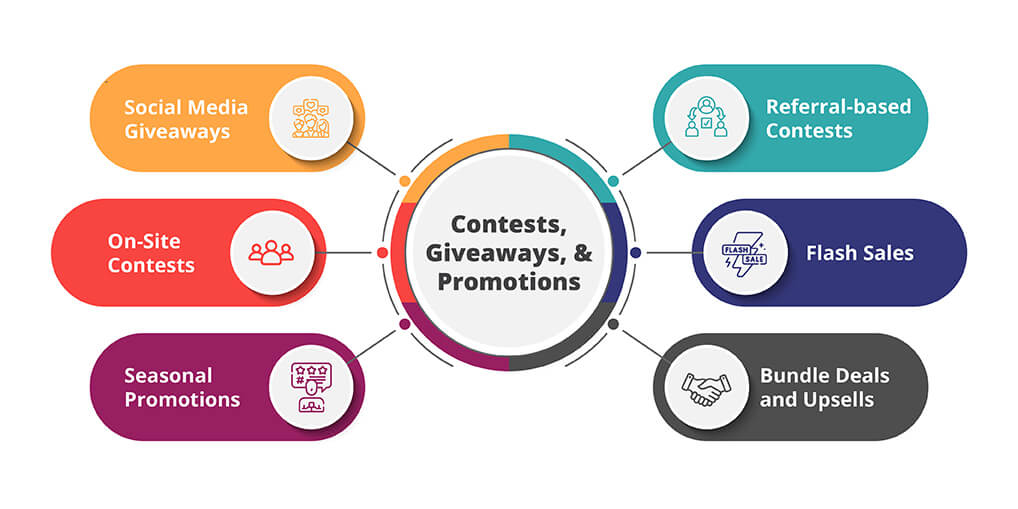
- Social Media Giveaways: Host a giveaway on Instagram or Facebook. Entry requires sharing your post, tagging friends, or following your profile. Each share exposes your brand to new audiences. For example, “Tag two friends and like this post to win a free product!” can rack up shares. Shopify notes that “social sharing gives sweepstakes a chance to go viral, quickly expanding reach.”
- On-Site Contests: Use Shopify apps (like KingSumo or Rafflecopter) to create entry forms on your site or landing pages. Collect email addresses in exchange for contest entries, turning participants into subscribers. Promote the contest via social and email to drive traffic back to the entry page.
- Seasonal Promotions: Tie giveaways to holidays or events. Customers expect big discounts around these times so that a well-advertised sale can bring traffic to your Shopify store.
- Referral-based Contests: Encourage your customers to refer the most friends.
- Flash Sales: Limited-time sales (e.g., a 24-hour flash sale) create urgency. Promote them across all channels, which drives immediate spikes in traffic. Use countdown timers on your site to emphasize scarcity.
- Bundle Deals and Upsells: While not contests, offering bundle deals and upsells can increase the average sale and encourage browsing more pages, effectively increasing traffic per visitor.
Tools to Use: Several Shopify apps streamline promotions (you can find contest, referral, and promotional offer apps in the Shopify App Store). Use them to ensure smooth entry tracking and data analysis.
10. Offline & Local Strategies
Even if you sell online, offline tactics can boost online traffic:
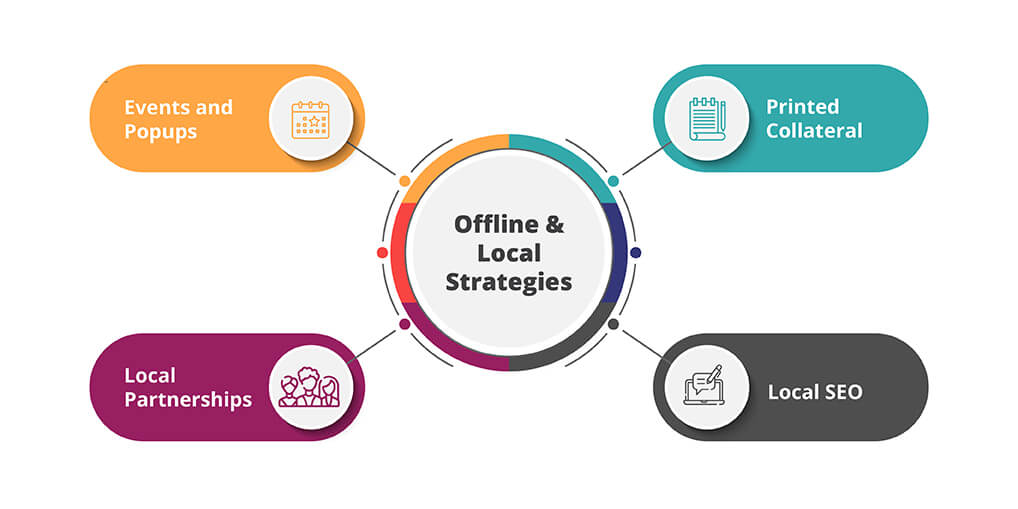
- Events and Popups: Participate in local craft fairs, popup shops, trade shows, or farmers markets. Let visitors experience products firsthand. Hand out business cards or flyers with your Shopify URL and a special discount code. According to Shopify, these face-to-face interactions help build brand awareness and trust.
- Local Partnerships: Collaborate with complementary local businesses to display your flyers or co-host events. Cross-promotional partnerships expand reach.
- Printed Collateral: Branded merchandise (stickers, postcards, QR code flyers) can direct local customers to your Shopify store. Include the QR code linking to a landing page or sale.
- Local SEO: As mentioned, optimizing your Google Business Profile and collecting local reviews can bring neighborhood customers online. If you also have a local storefront or pickup point, ensure your address and contact info are up-to-date online. Local customers who discover you via Google might browse and purchase from your Shopify site.
These strategies are especially important for B2C businesses with a local customer base. They create an offline buzz that translates to online traffic when people share about your brand or look you up later.
11. Analytics and Continuous Optimization
Driving traffic is only half the battle, and ensuring it converts is the other. Regularly analyzing your traffic sources and behavior is crucial:

- Use Shopify Analytics: Shopify’s built-in reports show which channels bring the most traffic and sales. Monitor trends. If one source underperforms, test tweaks.
- Google Analytics: Install GA4 on your store for deeper insights. Track sessions, bounce rate, and eCommerce conversions by traffic source. Use this data to allocate your marketing budget effectively.
- Set Clear Goals: For each channel, set KPIs. For example, “Increase organic traffic by 20% in Q4” or “Grow email-driven sales by 15% this month”. Shopify’s email guide suggests aligning email goals with broader objectives. This keeps your strategy purposeful.
- A/B Testing: Continually experiment. Test different landing pages, headlines, ad images, or email subject lines. Small improvements can compound. For instance, changing one word in an ad headline or email CTA can measurably boost clicks.
- Conversion Rate Optimization (CRO): As you drive more traffic, focus on turning visitors into customers. Optimize your Shopify theme’s checkout flow, simplify navigation, and show trust badges. A faster, smoother experience ensures that extra traffic results in more sales, not just pageviews.
Conclusion
With the increase in competition, your Shopify store needs a better marketing strategy to stand out. Targeting the relevant audience can give you the right traffic, which converts into sales. Choose your marketing strategy according to your budget. This way, you can get the most out of your money while attracting more customers. If you are a business owner looking for Shopify Development Services, We are here! Ayatas Technologies specializes in driving traffic and boosting sales for Shopify stores. Let’s grow your business together! Contact us for a free quote.



